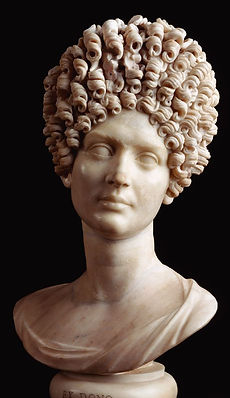<A>
early Christian/late Classical (ornamentation plus figure): *
reliefs from the “Arch of the Silversmiths” located in the Baotian Forum, finished 204 AD, built by Roman money changers in honor of Septimius Severus. The pilasters and architrave of this arch are covered with a plane acanthus ornamentation; one of the decorative reliefs depicts the emperor and his wife Julia Domma, he wears priestly attire while making a sacrifice.

<B>
Carolingian/early Romanesque (ornamentation + figure): *
capital (1050), a historiated capital, representing the Visitation, from the ground level of the tower-porch
see illustration

<C>
Roman portrait busts (stylized hair): *
Marble portrait of the emperor Antoninus Pius (period: Antonine, A.D. 138–161), marble Flavian Woman, bust from Rome 90 AD
see illustrations


<D>
“chisel-work and drill-work side by side”: *
In this garland sarcophagus from Aphrodisias (late 2nd or 3rd century AD) we see the unfinished garland on the right remained in a purely geometric form while on the left the decorative details of the garland, the central flower motif & the corner support were defined with the tooth chisel. All of these details were then finely shaped with the flat chisel. Finally the definition of the grapes was achieved with the drill, the marks of which can be seen in places though not all over the bunch.

<E>
sarcophagi (3rd century): *
This third century sarcophagus (Church of Santa Maria) served as the tomb of a relatively prosperous third century Christian. Early Christian art borrowed many forms from pagan art.

<F>
Basilica of Maxentius (aka Basilica of Constantine): *
It consisted of a central nave covered by 3 groin vaults suspended 39 meters above the floor on 4 large piers, ending in an apse at the western end containing a colossal statue of Constantine. The lateral forces of the groin vaults were held by flanking aisles measuring 23 by 17 metres, spanned by 3 semi-circular barrel vaults perpendicular to the nave, and narrow arcades ran parallel to the nave beneath the barrel vaults. The nave itself measured 25 metres by 80 metres creating a 2000 square meter floor. Like the great imperial baths, the basilica made use of vast interior space with its emotional effect.
